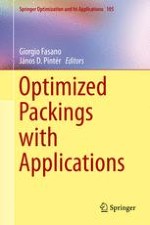2015 | OriginalPaper | Chapter
6. Cutting and Packing Problems with Placement Constraints
Authors : Andreas Fischer, Guntram Scheithauer
Published in: Optimized Packings with Applications
Publisher: Springer International Publishing
Activate our intelligent search to find suitable subject content or patents.
Select sections of text to find matching patents with Artificial Intelligence. powered by
Select sections of text to find additional relevant content using AI-assisted search. powered by
